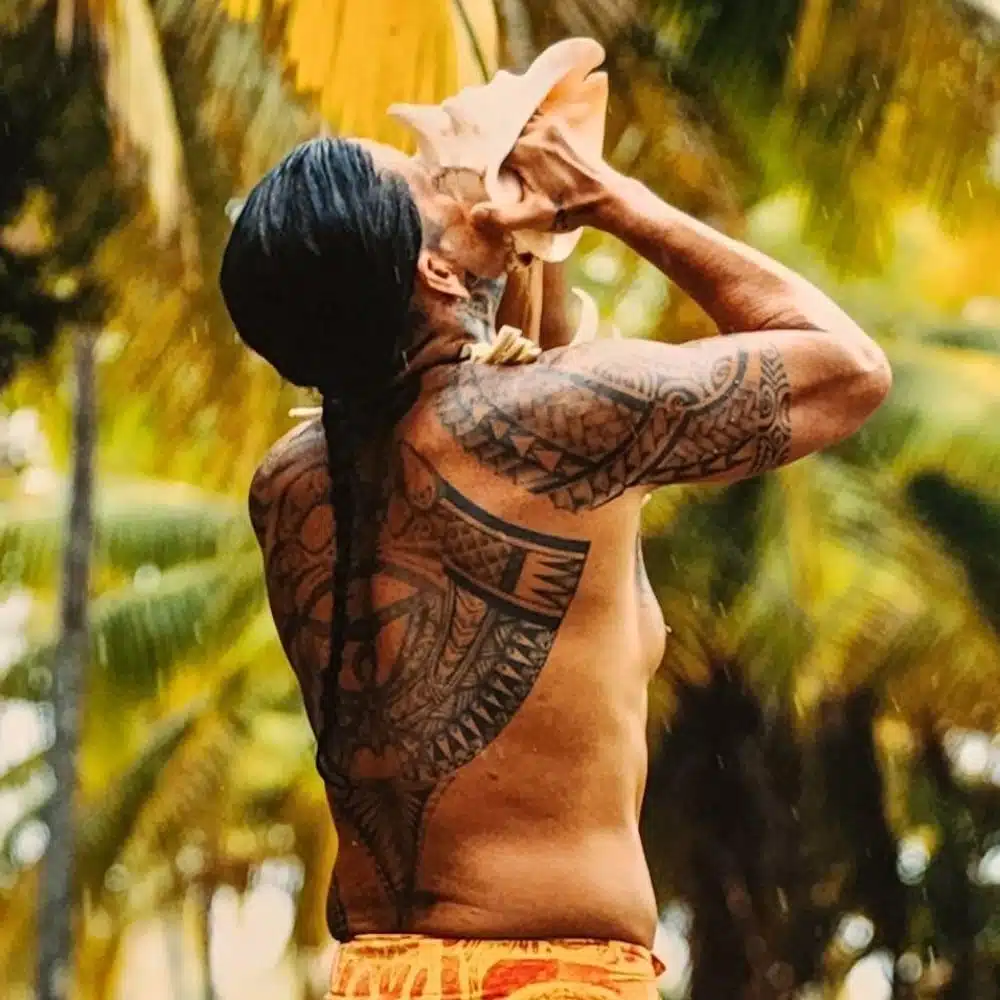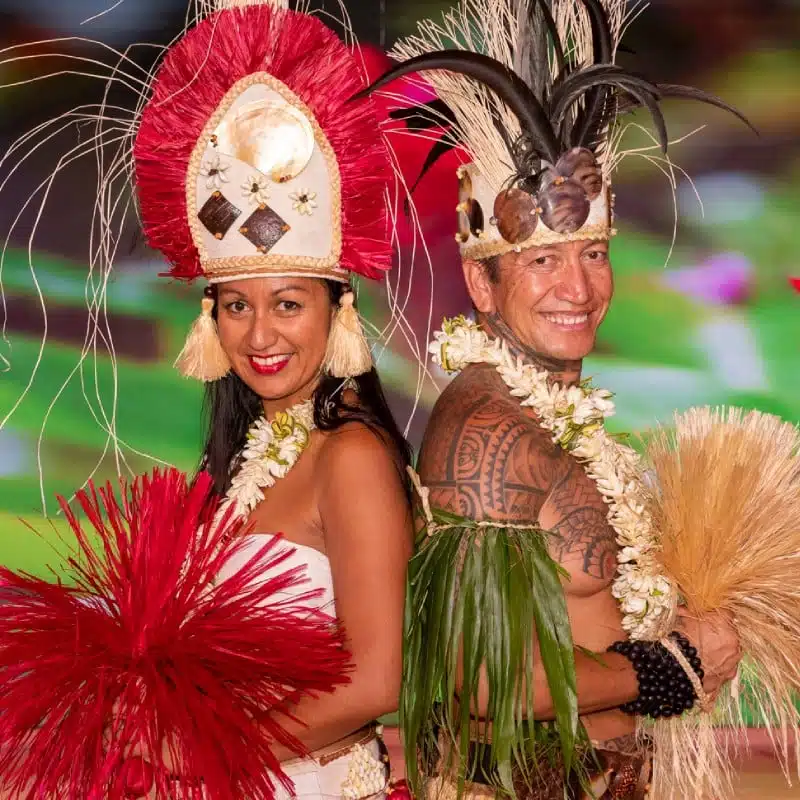An interview with Hinanui Ina and Mihimana
As the lucky passengers who have sailed aboard the Paul Gauguin know well, the ship’s heart and soul reside in the Gauguines and the Gauguins, the Tahitian hosts and hostesses who guide travellers through their journey of discovery around Polynesia and its culture. During the cruise, they serve as ambassadors for the islands where they grew up, but also for the ocean – or moana in Tahitian – which has nourished and protected them. Hinanui Ina is part of this small team. We met with her to find out more.
Can you tell us a little about yourself?
I’m from Tahiti, like every Gauguine and Gauguin. And like most of us, I have a Tahitian name with its own meaning. In the Polynesian belief system, Hina is the name of the goddess of the moon. And Nui means “great”. So Hinanui means “the great Hina”.
Was working on board a ship the obvious choice for you?
No, not at all! I started out as a musician on the Paul Gauguin, and I instantly loved the job and life on board the ship. It’s a fantastic experience to be able to welcome passengers from all over the world, sing, dance, share our culture and so on. I couldn’t imagine anything better. And it’s a way for us to rediscover our islands.

Who are the Gauguines and the Gauguins?
There are seven of us, four women and three men. We are dancers, musicians and singers, among other roles. We are all perfectly bilingual in French and English, so we’re fully equipped to look after our international guests. And most importantly, we are very knowledgeable about our culture. Sometimes people describe us as facilitators, but we are more than that. In addition to welcoming passengers, our most important “mission” is to take them into the heart of Polynesia, so they can experience our culture and traditions.
How does this translate in practical terms during the journey?
It’s simple, really – we offer passengers all kinds of different activities throughout their adventure. We’re absolutely everywhere on the boat, we’re very visible and everyone knows about us. But we don’t just stay on deck. The Gauguines and Gauguins disembark so we can guide passengers during their stopovers. This way, we can inform them about what they are about to discover. They can access the best elements of our culture through us.

What it Means to Be Tahitian for Mihimana
Mihimana is also a Gauguin. His name means “thought as power”. He shares his vision of Polynesian culture below.
“Tahitians are friendly, cheerful, polite and always ready to help other people. Of course, these days many young people have lost touch with our legends. However, Tahitians still have a respectful and indivisible relationship with the sea. It’s said that when a Polynesian dies, his or her soul returns to the ocean. We go out to sea with a wreath of flowers on our canoes or surfboards. We sing and throw the wreath into the sea to pay our respects to the person we have lost. We have families who perpetuate this deep bond with the ocean by tattooing the totem sea creature that acts as their symbol and tells their story onto their bodies, and they do this generation after generation. It could be a shark, a dolphin or a sea turtle, for example. It’s always a sacred ocean creature.”
What aspects of your culture do you share with passengers?
It might be some basic Tahitian dance steps or a few words from our language. In terms of crafts, we introduce people to the secrets of braiding. On land, we use coconut fronds to make wreaths. At sea, we use pandanus palms, a raw material widely used in Polynesia to make outfits, baskets and hats. Passengers are also very curious about our tattoos and their history and meaning – in fact, many of them leave with a turtle or flower tattoo of their own. We also put on a 45-minute show at the very start of the cruise. This is a very important opportunity for us to share our culture.
How does learning about another culture make travelling a more enriching experience?
When passengers arrive, they all have more or less the same picture postcard image of the sea, the beach, the fine sand, the coconut trees and so on. Of course, that image really does exist and we are here to show it to them. But we are also here to show them another Polynesia, which is all about our way of life, the importance of simple things, our kindness. This is what the people who come see us find the most fascinating. Our greatest talent is welcoming people in a very natural way! It is often said that the Gauguines and the Gauguins are the heart and soul of the ship. We never forget that, for some passengers, this journey is a lifelong dream. It’s our duty to make the experience unforgettable.

Where do you think the Polynesian art of hospitality comes from?
Hosting people is part of how we’re brought up. On the islands, if you walk along the beach and there is a family picnicking, there is a good chance that they will ask you to come and share their meal. That is totally normal in Polynesia. Living in small spaces makes people supportive of one another and gives them a sense of community. It’s easy to talk on a small island where everyone knows each other.
What’s the nicest thing someone has said to you at the end of a cruise?
“We’ll come back.” And they do. At the end of each cruise, we usually sing a Polynesian song. It often leaves the passengers in tears. It’s always a very emotional moment for them and for us. Even though we have only been on the ship for a week or two, a lot of our time has been spent together.

Ta’aroa, the great creator
First, there was Ta’aroa, the ancestor of all the gods in the Polynesian pantheon and the supreme being which created everything. After spending millennia surrounded by the void, a dark and silent world without earth, sky or sea, sun, moon or stars, Ta’aroa decided to break out of his divine cocoon. From his shell, he made rocks and sand. From his spine, he made mountains. His tears filled the oceans, lakes and rivers. His nails became the scales on fish and turtles. His feathers became trees and bushes. Finally, his blood formed the colours of the rainbow. Then came ’Oro, his eldest son and ruler of the world; Tane, his brother and the god of peace and beauty;
Hina, the goddess of the moon; and the demigod Maui. These are just some of the hundreds of gods that live in the heavens, water, forests, mountains and so on. It was only much later that Ta’aroa finally created humankind.
Crédits photos : ©

PONANT takes you there
Discover the way of life lived by the people of the sea



